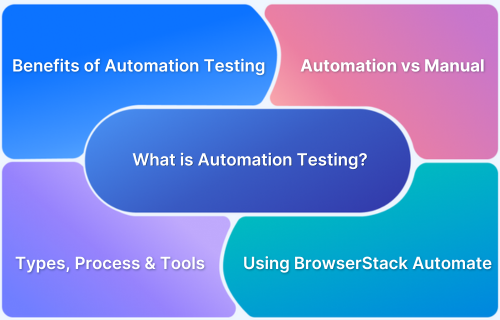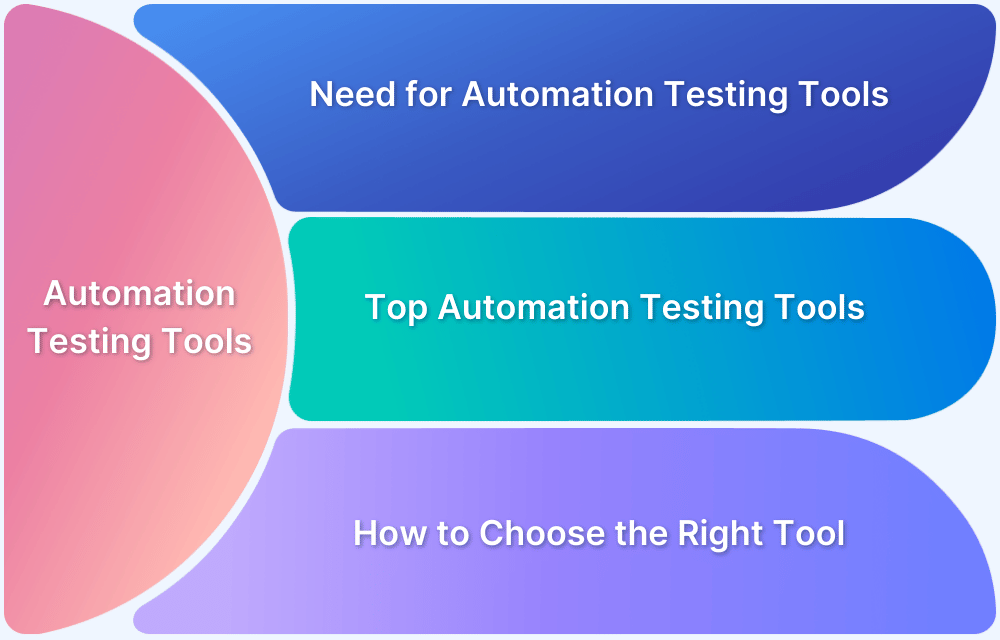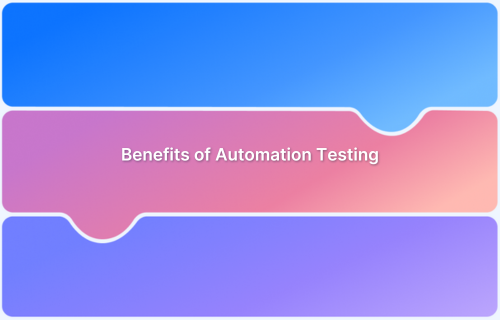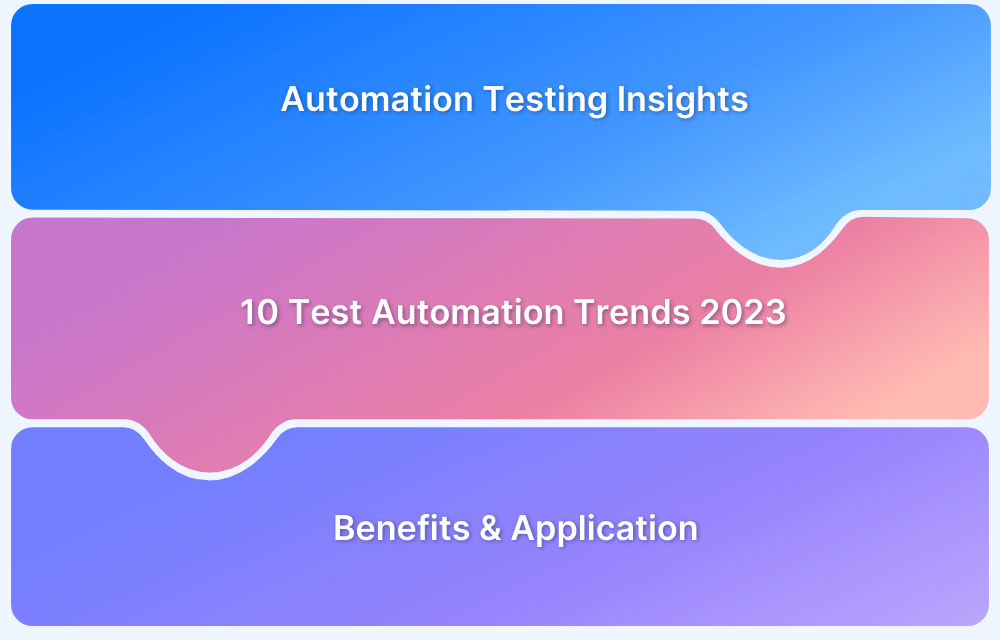Automation Testing plays a crucial role in modern software development, especially in Agile and DevOps environments, by accelerating the testing process and improving reliability.
Overview
What is Automation Testing?
The process of Automation testing involves using specialized software tools to execute test cases automatically, eliminating the need for manual intervention.
Why is Automation Testing Important?
It has the ability to streamline repetitive tasks, improve test coverage, and identify issues earlier, ultimately leading to faster deployment cycles.
Top Tools for Automation Testing
- Selenium: Open-source web automation for multiple browsers and languages.
- BrowserStack Automate: Runs tests on 3,500+ real devices and browsers with top frameworks.
- BrowserStack App Automate: Mobile app testing on real Android & iOS devices.
- Cucumber: BDD tool for human-readable automated tests.
- Appium: Cross-platform mobile automation for Android & iOS.
- Percy: Visual regression testing for UI consistency.
- App Percy: Mobile app visual testing on real devices.
This article explores the benefits, strategies, and tools that make automated testing an essential component of the development lifecycle.
What is Automation Testing?
Automation testing is the use of specialized tools or scripts to automatically execute predefined tests on software applications. It eliminates manual intervention by automating repetitive tasks like regression tests, improving test efficiency and coverage.
This approach allows testers to focus on more complex tasks while ensuring faster execution, increased accuracy, and greater test coverage, making it essential for modern software development.
Benefits of Automation Testing
Automation testing has become an essential part of modern software development. Here are some key benefits:
- Cost Savings: Reduces long-term costs by minimizing manual effort and speeding up development cycles.
- Early Bug Detection: Identifies defects early, reducing the cost and effort of fixing issues later.
- Faster Feedback: Provides quick feedback, enabling faster decision-making and reduced development time.
- Better Resource Utilization: Automates repetitive tasks, freeing up resources for more complex work.
- Improved Accuracy: Eliminates human errors, ensuring reliable and consistent test results.
- Increased Coverage: Tests more scenarios, improving the quality and reliability of the software.
- Speed: Automated tests run faster, ideal for time-consuming tests like regression or load testing.
- Higher ROI: Delivers faster releases, better quality, and less manual testing, maximizing long-term returns.
Automation Testing vs Manual Testing
Both manual and automation testing approaches have their significant place in the SDLC. The choice between them depends on various factors, including project requirements, time constraints, budget, system complexity, and the testing team’s skills and expertise, as listed below.
| Criteria | Manual Testing | Automation Testing |
| Accuracy | Lower accuracy due to the higher possibility of human errors. | Depicts a higher accuracy due to computer-based testing eliminating the chances of errors. |
| Testing at Scale | It needs time when testing is required at a large scale. | Easily performs testing at a large scale with the utmost efficiency. |
| Turnaround time | Takes more time to complete a testing cycle, and thus the turnaround time is higher. | Completes a testing cycle within record time; thus, the turnaround time is much lower. |
| Cost Efficiency | Costlier as it involves hiring expert professionals. | It saves costs incurred once the software infrastructure is integrated; it works for a long time. |
| User Experience | Ensures a high-end User Experience for the software’s end user, as it requires human observation and cognitive abilities. | It cannot guarantee a good User Experience since the machine lacks human observation and cognitive abilities. |
| Areas of Specialization | To exhibit the best results, manual Testing should be used to perform Exploratory, Usability, and Ad-hoc Testing. | Automation Testing should be used to perform Regression Testing, Load Testing, Performance Testing, and Repeated Execution for best results. |
| Skills | Testers must be able to mimic user behavior and build test plans to cover all the scenarios. | Testers must be highly skilled at programming and scripting to build and automate test cases. |
Follow-Up Read: Manual Testing vs Automation Testing
Which Tests should be Automated?
Automating the right tests improves efficiency, accuracy, and test coverage. The following types of tests should be prioritized for automation:
- Repetitive & Monotonous Tests: Frequently executed test cases, such as regression and smoke tests, benefit from automation.
- Data-Driven Tests: Tests requiring multiple data sets, like form validations and database testing, should be automated to ensure consistency.
- Business-Critical Tests: High-risk functionalities impacting core business operations should be automated for continuous validation.
- Deterministic Tests: Test cases with clear pass/fail criteria, such as UI validations and API responses, are ideal for automation.
- Cross-Platform & Environment Tests: Tests that need execution across different OS, browsers, or devices should be automated to ensure compatibility.
- Time-Consuming & Tedious Tests: Repetitive tasks prone to human error, like performance and load testing, should be automated for efficiency.
Read More: How To Improve Automation Test Coverage
Types of Automation Testing
Automated testing covers various testing methods to ensure software quality, functionality, and security. Below are some key types:
- Regression Testing: Regression suites are ever-increasing and require the same variables to be filled numerous times to ensure that new features do not tamper with older functions. This can easily be automated.
- Smoke Testing: Run automated suites to verify the quality of major functionalities. This saves time by quickly analyzing whether a build requires more in-depth testing.
- Data-driven Testing: Automate tests to validate functionalities that must be tested repeatedly with numerous data sets.
- Performance Testing: Automate tests that monitor software performance under different circumstances. Doing this manually would be incredibly detailed and time-consuming.
- Functional Testing: Every time a developer submits a PR, functional testing needs to be executed quickly and provide immediate feedback. This is impossible to achieve without automation, especially as organizations scale up.
- Security Testing: Identifies vulnerabilities, risks, and security gaps within an application to prevent potential threats and breaches.
- Acceptance Testing: Conducted after system testing to evaluate whether the software meets end-user requirements and business objectives.
- API Testing: Validates the functionality, security, and reliability of an application’s APIs, ensuring seamless communication between software components.
- UI Testing: Ensures that all user interface elements, such as buttons, fields, and layouts, function correctly and provide a smooth user experience.
- Unit Testing: Tests individual components or units of code in isolation to verify their correctness and functionality during development.
What is the Process of Automation Testing?
Below is a step-by-step method of the process involved in automation testing:
- Define Goals: Before starting automation, be clear about your long-term and short-term goals of test automation. Discussing the road map with higher management and stakeholders would be best.
- Test Approach Planning: There are different testing levels; automation is often confused with end-to-end testing, but there are many levels. The best approach is to create test pyramids.
- Choose a Framework: Once you know the business value, the most critical part is the type of framework you choose. There are different types of automation frameworks; you need to discuss them with the team and choose the right one.
- Test Automation Environment: You should also know which environment the application under test will be used for validation, such as dev, staging, production, or all of these. Additionally, the ideal test grid should enable parallel testing. This means testers should be able to run multiple tests on multiple devices simultaneously.
- Risk Analysis: Analyzing and communicating the risk to management is essential. Automation testing may have some risks based on your tools and strategy.
- Create, Execute, and Maintain Tests: Start creating the automation tests for the critical features first. Once you create the test cases, execute them often. Timely maintenance is expected for automation test cases as there will be active development in the background.
- DevOps Integration: A DevOps integration also reduces the dependency of the testing team; anybody can execute and get the report.
- Test Reporting: The test report must have numbers of total test cases, passed, failed, etc. The report must be understandable for any non-technical person.
- Review and Retrospect: Continuously review your test scripts, and understand what is causing false failures and what is impacting test case creation. How can you do it better? This task is not only for test case creation. This may also include modifying the automation strategy, which should not deviate from your original goals.
Valuable Resources while Implementing a Test Automation Strategy:
- How to Create a Test Automation Strategy
- How to Define KPI for Automation Testing Teams
- 10 Test Automation Trends
Automation Testing Frameworks
Automation Testing Frameworks are a set of rules and corresponding tools that are used for building test cases. It is designed to help engineering functions work more efficiently. To streamline the process, you can consider using some of the top 10 web automation testing tools available in the market.
The general rules for automation frameworks include coding standards that you can avoid manually entering, test data handling techniques and benefits, accessible storage for the derived test results, object repositories, and additional information that might be utilized to run the tests suitably.
Here’s a list of popular frameworks used for Automated Testing:
- Selenium: Selenium is used to run Automation Tests on web applications. It is primarily used for browser automation and running UI Tests to check the website’s functionality.
- Appium: Appium runs Mobile Automation Tests and checks if the application functions as expected. You can test both iOS and Android applications on Appium.
- Cypress: Cypress helps run automation tests for web applications. You can run E2E Tests and Component Tests using Cypress.
- Playwright: Playwright is used to run automated tests on different browsers for websites. You can even run tests on headless browsers using Playwright.
- Puppeteer: Puppeteer is a web automation framework that runs functional tests on web applications. You can run automated tests on headless browsers using Puppeteer.
- Espresso: Espresso helps run automated tests for Android applications. You can test different workflows for your Android application using Espresso framework.
- XCUITest: XCUITest helps run automated tests for iOS applications. You can test different functionalities of your iOS application using XCUITest.
Top Tools for Automation Testing
Automation testing relies on various tools to streamline the testing process, improve accuracy, and reduce manual effort. Below are some of the top test automation tools available:
Popular Automation Testing Tools
- Selenium: A widely used open-source framework for web application automation, compatible with multiple browsers and programming languages.
- BrowserStack Automate: Enables automated testing on 3,500+ real devices and browsers. It works with frameworks like Selenium, Cypress, Playwright, and Puppeteer for reliable web automation.
- BrowserStack App Automate: Designed for mobile app testing on real Android and iOS devices. It seamlessly integrates with Appium, Espresso, and XCUITest for efficient mobile automation.
- Cucumber: A behavior-driven development (BDD) tool that supports automated testing with human-readable test scripts, making collaboration easier.
- Appium: A leading mobile automation framework that supports cross-platform testing for Android and iOS applications.
- Percy by BrowserStack: A powerful tool for automated visual regression testing, ensuring UI consistency through pixel-by-pixel comparisons.
- App Percy: Extends Percy’s capabilities to mobile applications, allowing visual testing on real devices to detect UI inconsistencies.
How to Choose an Automation Testing Tool?
Choosing the right tool enhances efficiency, reduces costs, and improves test coverage. Here are some factors to consider:
1. Budget Consideration: Assess initial costs, including tools, training, and infrastructure.
2. Essential Features:
- Real device and browser testing
- Support for multiple programming languages and frameworks
- CI/CD integration
- Debugging and test reporting capabilities
3. Team Expertise: Ensure the tool aligns with your team’s technical skills or plan for upskilling.
4. Technical Support: Opt for tools with reliable customer support or an active open-source community.
Why Choose BrowserStack for Automation Testing?
BrowserStack stands out as a comprehensive testing solution due to:
- Real Device Testing: Run tests on actual devices instead of emulators or simulators.
- Seamless Integrations: Works with Selenium, Appium, Cypress, and other leading frameworks.
- Scalability: Supports parallel testing to speed up test execution and reduce build times.
- Reliable and Secure: Enterprise-grade security with zero maintenance hassles.
With BrowserStack, teams can execute automated tests efficiently, ensuring high-quality software delivery at scale.
Limitation of Automation Testing
There are some challenges and disadvantages when it comes to automation testing. There are many reasons of its failures. Below is a list of some common limitations and points for consideration:
- Lack of Specific Goals: Without clear objectives, automation efforts can become inefficient, leading to wasted resources.
- Not Knowing What to Automate: Teams often struggle to identify which test cases should be automated, impacting test coverage and effectiveness.
- Lack of the Right Skills and Tools: Inadequate skills or tools can hinder the successful implementation of automation strategies.
- Low Visibility: Automation testing can sometimes lack proper tracking, making it hard to monitor progress and catch issues early.
- Difficulty in Testing Applications: Complex applications, especially those requiring human judgment (e.g., usability and design), cannot always be tested automatically.
- Inability to Automate All Tests: Certain tests, such as those involving graphics, sound, or user-friendliness, cannot be fully automated.
- Programming Knowledge Required: Test scripts for automation tools often require programming knowledge, limiting their use to teams with coding expertise.
- False Positives and Negatives: Automation tests can sometimes produce inaccurate results, flagging issues that don’t exist or missing actual problems.
Must Read: Common Reasons for Automation Tests Failure
Explore a comprehensive video on how The Weather Company transitioned from manual to automation software testing on BrowserStack.
Automation Testing Best Practices
Running automated tests efficiently and effectively requires following automation best practices to maximize their benefits. Here are some key best practices for running automated tests:
- Test Suite Organization: Organize your automated tests into logical test suites or categories based on functionality, modules, or test types. This allows easier test management, selective test execution, and better traceability.
- Test Data Management: Maintain separate and manageable test data sets for different test scenarios. A dedicated test data strategy helps ensure test data consistency, isolation, and ease of maintenance.
- Test Environment Setup: Set up and configure your test environment to resemble the production environment to ensure accurate test results closely. This includes replicating hardware, software, network configurations, and dependencies. Consider using virtualization or containerization technologies for efficient environment provisioning.
- Test Execution Order: Define a specific execution order for your automated tests to minimize dependencies and ensure smooth execution. Tests with fewer dependencies or independent test cases can be executed first, followed by tests that rely on their successful execution.
- Parallel Test Execution: Utilize parallel testing capabilities provided by your test automation framework to distribute test execution across multiple environments or machines.
- Test Execution Frequency: Determine the appropriate frequency for running automated tests based on project needs. For fast-paced development cycles, consider running tests on each code commit or as part of continuous integration (CI) pipelines.
- Test Reporting and Logging: Implement robust test reporting and logging mechanisms in your test automation framework to capture test results, errors, and relevant logs. Clear and detailed reports help identify test failures, understand the root causes, and facilitate effective debugging.
- Test Result Analysis: Regularly review and analyze test results to identify patterns, trends, and areas for improvement. Identify flaky tests (tests that intermittently fail) and address their root causes to ensure reliable test results. Use historical test data to track stability, identify performance trends, and monitor test coverage.
- Test Failure Investigation: When a test fails, investigate and diagnose the failure promptly. Collect relevant information such as error messages, stack traces, screenshots, or video recordings to aid in debugging. Conduct root cause analysis to determine whether the failure is due to an application defect, environmental issue, or test script problem.
- Test Maintenance: Maintain your automated tests by regularly updating them to reflect changes in the application, such as new features, user interface modifications, or underlying technology updates. Address test script failures promptly, refactor tests as needed, and keep the test suite aligned with the evolving requirements.
Conclusion
Automation testing is an integral part of any testing ecosystem. Comprehensive testing becomes difficult without moving to an automation setup, as does meeting ever-shortening deadlines.
Consequently, it is important to initiate automation testing protocols as early as possible in a way that balances and complements manual testing.







